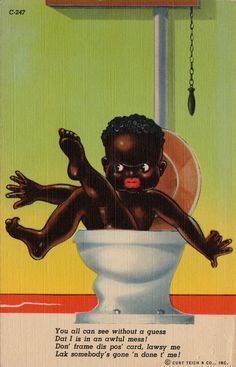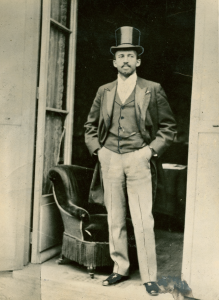Reconstruction by the Obama Court Historian: Henry Louis Gates Jr.’s Stony the Road
Morris van de Camp1,063 words
Although he was a supporter of President Obama, Henry Louis Gates Jr. did the President no favor when Gates made a scene and was arrested by a Massachusetts cop in 2009. Obama unwisely commented on the matter and had to hold a “beer summit” to smooth things over later. The cost of Gates’s temper tantrum was staggeringly high: In no small part due to their racial animus, Gates (and the President) turned a minor misunderstanding into a national firestorm, all during a massive economic crisis and while Obama was trying to navigate his health care reform through Congress.
Recently, Gates wrote a study of black history from the end of Reconstruction to the rise of segregation policies, (i.e. “Jim Crow”). No expense was spared in publishing the book; the images are in color and each page is glossy. For this website’s European readers, “Reconstruction” is the name for the policy by which the United States government dealt with the defeated former Confederate States, including dealing with newly freed black slaves. It didn’t go well. The leaders of Reconstruction became disillusioned and ended the policy.
The first two-thirds of Stony the Road is a focus on metapolitics and other cultural works from the era after the end of Reconstruction in 1877 until the late 1940s. Gates focuses on two sets of cultural works: The first is the 1915 film The Birth of a Nation and the second is what Gates calls “Sambo Art,” art used in advertising gimmicks and postcards that exaggerates African features in a comical way.

An example of what Gates calls “Sambo Art.” From Mammy’s.
The New Negro
The best part of the book is the section on the activists who were called “The New Negro” at the time. These were black activists such as W.E.B. Du Bois and Booker T. Washington. The New Negro activists came of age or were born after slavery’s end and were financially successful.
These activists had a variety of strategies for advancing their people, but they settled on the worst strategy possible — at least for whites — which was to seek to end desegregation. Repatriation to Africa was a serious strategy by some of the New Negro activists, however. Du Bois eventually moved to Africa himself. Gates describes the interpersonal drama between the activists as well as the class differences among blacks.
What is striking is that the New Negro activists focused on metapolitics as much as anything else. They labored hard to make films like The Birth of a Nation and Sambo Art taboo. The New Negro also endeavored to maintain a respectable public appearance. In a process that was gradual and came to its apogee in the early 1950s, whites did come to believe that it was all just a “matter of skin color” and blacks won the “civil rights” battle — called a “Second Reconstruction” by its detractors in the South.

The image of The New Negro, W.E. B. Du Bois. The New Negro activists were conscious of optics.
Critical Thinking
While Gates does agree with the philosophy of using metapolitics and culture to advance racial aims — much like the North American New Right does — there is much to criticize in his book. It was to my disappointment that Gates didn’t bother to look seriously at the ideas of the men that ended Reconstruction. It’s a huge oversight. For example, one of the Reconstruction governors of South Carolina, Daniel Henry Chamberlain, had led black cavalry troopers during the Civil War. He came from an abolitionist tradition, and yet all he could say of Reconstruction later was that it was “incompetency, dishonesty, corruption in all its forms. . .” [1] This turnabout is remarkable. Most of the time, people that sacrifice for a cause, such as Chamberlain, double down on their beliefs rather than reject them.
In focusing on Sambo Art and The Birth of a Nation, the book misreads the data. The Birth of a Nation came out nearly four decades following the end of reconstruction. It was not the cause of Jim Crow, but a fictional representation of why Jim Crow existed in the first place. Indeed, when Jim Crow restrictions were finally lifted with the 1964 Civil Rights Act (itself an illicit second constitution), the black community went on a decades-long crime wave that was worse than that depicted in the 1915 film. There is also some truth to Sambo Art. Most, if not all, African-American art forms — to include gangster rap, the musical Hamilton, Michelle Obama’s dancing, and the paternity test-takers on daytime TV — are engaging in some form of Sambo Art. There’s truth in jest.
Other rightist thinkers have argued that all black events boil down to a self-absorbed discussion of “blackness.” For example, Gates argues that a series of questions crystalized during Reconstruction [2] that still impact American domestic politics today. Namely:
- Who is entitled to citizenship?
- Who should have the right to vote?
- What is the government’s responsibility in dealing with terrorism?
- What is the relationship between political and economic democracy?
These questions didn’t arise during Reconstruction. The ancient Greeks asked those questions and more. So did the American Founders. During Reconstruction, white abolitionists and the Republican Party changed the answers to the first two questions to include black Africans in North America. In 1877, those same abolitionists recognized their mistake and changed the answers again.
Gates reminds the reader that the reaction against Reconstruction lasted a great deal longer than Reconstruction itself, and sees a parallel reaction to the Obama administration in the alt-right. Gates is also baffled by “white supremacy” and why it exists — so I’ll attempt to explain why whites react negatively to Africans:
- As a group, blacks are dangerous.
- All black-run societies are failures.
- Blacks in white institutions cause things to break in some way — such as the economy in 2008.
- “Civil rights” had an implied agreement: Blacks had to behave in a civically virtuous way. On a large enough scale, things like the OJ Simpson verdict and the arrest of Henry Gates void the deal.
I can only hope that Gates is correct, and the pro-white reaction to the Obama administration will last as long as Jim Crow did.
Notes
[1] Halsey, Francis W. et al, Great Epochs in American History Vol. IX The Reconstruction Period 1865 – 1877, Funk & Wagnalls Co, New York & London, 1912 Page 195
[2] Gates, Henry Louis, Stony the Road: Reconstruction, White Supremacy, and the Rise of Jim Crow, Penguin Press, New York, 2019, Page 6
Reconstruction%20by%20the%20Obama%20Court%20Historian%3A%20Henry%20Louis%20Gates%20Jr.and%238217%3Bs%20Stony%20the%20Road
Enjoyed this article?
Be the first to leave a tip in the jar!
Related
-
Introduction to Mihai Eminescu’s Old Icons, New Icons
-
Doxed: The Political Lynching of a Southern Cop
-
James M. McPherson’s Battle Cry of Freedom, Part 2
-
Counter-Currents Radio Podcast No. 581: Fourth Meeting of the Counter-Currents Book Club — Greg Johnson’s Against Imperialism
-
James M. McPherson’s Battle Cry of Freedom, Part 1
-
National Socialism as a Magical Movement: Stephen E. Flowers’ The Occult in National Socialism
-
Communist Barbarism in Hungary — and America Today: When Israel Is King
-
Introducing a Reactionary Aphorist
12 comments
Thanks to Mr de Camp for not only reading this so that others don’t have to, but for squeezing so much juicy stuff from it.
Can anyone recommend some red-pilling books on the Reconstruction period?
Volume 5 of A History of the American People by Woodrow Wilson, back when he was a history professor (1902) , goes into some of that:
https://ia801600.us.archive.org/2/items/in.ernet.dli.2015.213603/2015.213603.A-History.pdf
From that, you get a pretty good feel for how much graft was going on during those times. A few aspects about the vibrancy were glossed over, but one can read between the lines. Even so, if any professor today assigned the reconstruction section of Wilson’s textbook, or read it in class, it probably would be enough of a Narrative Violation to make the national news.
There’s kind of a bitter irony with it. Wilson also describes the rise of Fraternity Tri Kappa, and although he didn’t approve of some of that, he concludes basically that kicking your enemies while they’re down can cause major blowback. Later during his presidency, he didn’t heed this lesson.
Cool, thanks! Looking at today’s Detroit, New Orleans, Baltimore, etc., all the supposed ‘myths’ about Reconstruction black politicians seem pretty believable.
https://en.wikipedia.org/wiki/Dunning_School
The following is what PC historians don’t want you to know about the radical reconstruction:
http://www.thetribunepapers.com/2018/02/15/union-league-terrorism-reconstruction-series-part-2/
The article might lead one to believe that Booker T. Washington was oriented toward desegregation. Such is not the case. Unlike W. E. B. Du Bois, Washington actually live in the segregated South and took the approach that Negros needed to (a) be as self-sufficient as possible and (b) to be as good at their work (farming in particular) as possible. Washington (sagely) doubted that Whites would ever view the Negro as an equal, but that the Negro could, in time, make themselves so useful that Whites would ignore the inequality and deal with them as human beings. Du Bois, on the other hand, thought the White Man just needed to change his attitude toward the Negro and the Negro need change nothing (Black Supremacy). In the end, Du Bois vision of the way forward for Blacks because central to Black Political Catechism. Washington was, of course, right (as every black millionaire or billionaire will readily attest).
I read Counter-Currents every day. Not the place I usually turn for humorous uplift…
But I gotta say, all I saw was the title and the author of this clownery and it made me laugh.
Self-pity and self-aggrandizement in one black kettle.
These people have zero self-respect. I don’t even think they know what it is.
Understandably.
I knew Skip for many years and never read his pronouncements as other than advance promotion for his tenure (at Yale, then Harvard) and forthcoming books. But if I read this review correctly, it appears he has sunk from advertising copywriter to billboard designer.
Once again, tight work from our Morris.
Great essay.
What I want to know is that Gate’s and his driver were trying to gain accesses to the property, was Gate’s driver black or white? If he were white, which I think he was then the neighbor who called the police was genuinely concerned of a breaking and entering in progress.
On Gates (Wiki):
“He has learned through contemporary research that his family is descended in part from the Yoruba people of West Africa.[3] He also has learned that he has 50% European ancestry, including Irish; he was surprised it was that much.”
This was the very worst thing that came from slavery: giving our blood (and thus superiority) to these people. How many accomplished blacks have substantial admixtures of Europoid genetics in them, yet continue to be strong “race men” working against white perpetuity and interests?
Comments are closed.
If you have Paywall access,
simply login first to see your comment auto-approved.
Note on comments privacy & moderation
Your email is never published nor shared.
Comments are moderated. If you don't see your comment, please be patient. If approved, it will appear here soon. Do not post your comment a second time.
Paywall Access
Lost your password?Edit your comment